The Featured Creatures collection provides in-depth profiles of insects, nematodes, arachnids and other organisms relevant to Florida. These profiles are intended for the use of interested laypersons with some knowledge of biology as well as academic audiences.
Introduction
Habronattus is a large and diverse genus of New World jumping spiders in the family Salticidae (Griswold 1987, Maddison and Hedin 2003). These spiders are small (5–8 mm), primarily ground-dwelling, and can be found in a variety of habitats (Griswold 1987). As with most other jumping spiders, members of the genus Habronattus are voracious generalist predators that eat a variety of small insects and other arthropods, including many small agricultural pests (Taylor 2012). Habronattus males are known for their unique and elaborate color patterns, particularly on their faces and front legs, which they display to the comparatively drab females during courtship (Figure 1, Taylor et al. 2011, Elias et al. 2011). Although most spiders (including Habronattus) have venom that they use to subdue their prey (Foelix 2011), Habronattus jumping spiders are not aggressive or defensive and do not bite humans.
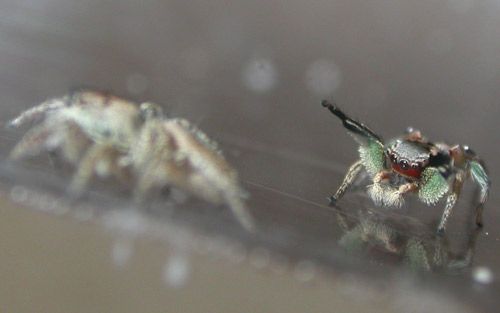
Credit: Lisa Taylor, UF/IFAS
Distribution
The genus Habronattus is restricted to the New World, mainly in North and Central America. Their distribution extends as far north as the Yukon in Canada across to New Brunswick, south through the US and Central America including the Galapagos Islands, the Lesser Antilles and other Caribbean islands (Griswold 1987). These spiders can be found in a variety of habitats including mountaintops, deserts, and riparian areas (Griswold 1987). In parts of their range, they are common and abundant in backyards, gardens, and agricultural areas (Griswold 1987, L. Taylor, and J. Coco, unpublished data).
There are eleven species of Habronattus known to inhabit Florida:
Habronattus alachua (Griswold, 1987)
Habronattus brunneus (Peckham & Peckham, 1901)
Habronattus calcaratus (Banks, 1904)
Habronattus carolinensis (Peckham & Peckham, 1901)
Habronattus coecatus (Hentz, 1846)
Habronattus decorus (Blackwall, 1846)
Habronattus georgiensis (Chamberlin & Ivie, 1944)
Habronattus notialis (Griswold, 1987)
Habronattus ocala (Griswold, 1987)
Habronattus trimaculatus (Bryant, 1945)
Habronattus viridipes (Hentz, 1846)
Identification
The genus Habronattus is in the jumping spider family Salticidae, the largest family of spiders, with more than 5800 species (World Spider Catalog 2015). Jumping spiders can be distinguished from other spiders by their large, forward-facing anterior median eyes (Figure 2). Most jumping spiders do not build webs for prey capture (but see Jackson 1992 for an exception). Silk use in most jumping spiders is limited to construction of draglines, resting retreats, and egg sacs (Richman and Jackson 1992). Jumping spiders are active during the day across a variety of habitats (Richman and Jackson 1992).
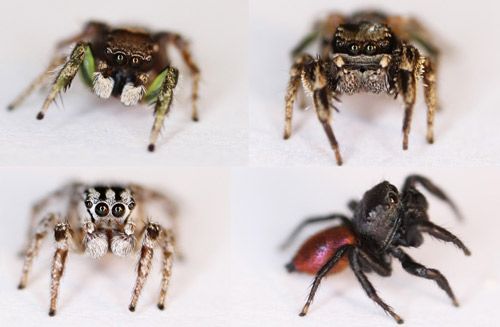
Credit: Lisa Taylor, UF/IFAS
The genus Habronattus contains roughly 100 species of relatively small jumping spiders and can be distinguished from other jumping spiders by the microscopic morphology of male pedipalps (small appendages near the face of the spider) and an elongated third pair of legs (Griswold 1987). However, the most striking features of Habronattus that can aid in identification are the elaborate color patterns of mature males that are used in their mating displays. Across the genus, colorful species-specific ornamentation appears on the face, pedipalps, first and third pairs of legs, and (less commonly) on the abdomen (Griswold 1987, Figures 2 and 3).
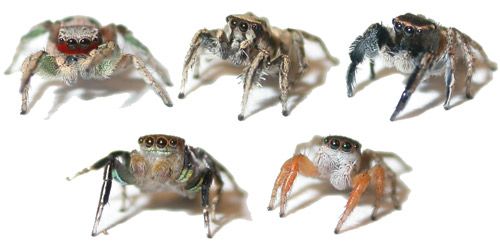
Credit: Lisa Taylor, UF/IFAS
In contrast with the males, the females of most Habronattus species look similar to one another with only subtle differences in their drab gray and brown markings (Griswold 1987, Figure 4).

Credit: Lisa Taylor, UF/IFAS
In the field, both males and females can often be seen jumping along the ground, across leaf litter, or through vegetation. Their small size can make them difficult to spot (Figure 5). The drab gray and brown dorsal coloration of females allows them to blend in with their environment (Figure 6), while males often have dorsal color patterns that make them more conspicuous (Figure 7). Males spend more time moving through their environment compared with females, making them easier to find (Taylor 2012).
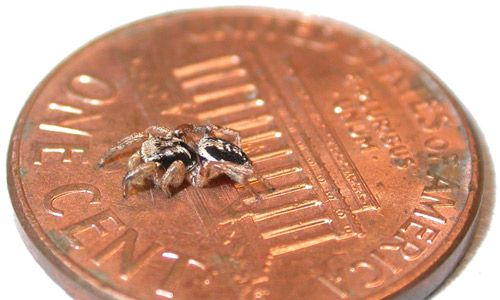
Credit: Lisa Taylor, UF/IFAS
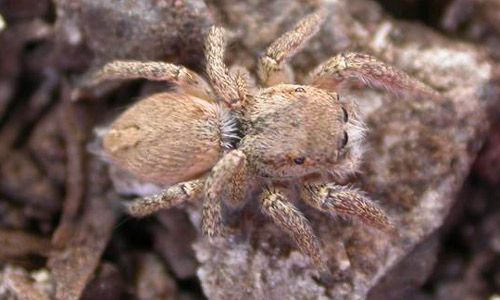
Credit: Lisa Taylor, UF/IFAS
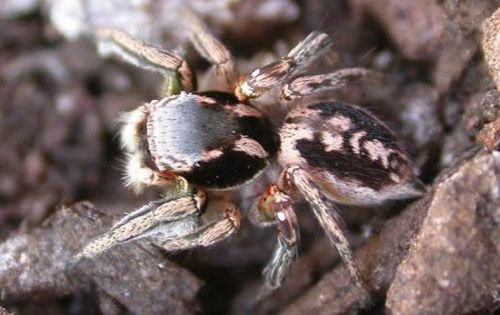
Credit: Lisa Taylor, UF/IFAS
A species-level key to males of the genus Habronattus can be found in Griswold (1987). Additional images useful for species-level identification can be found in Maddison (1995).
Vision
While there is evidence that many jumping spiders can see and discriminate a range of colors across both the UV and human visual spectrum (Nakamura and Yamashita 2000, Lim and Li 2006), members of the genus Habronattus use a unique color vision system that differs from other groups and provides an enhanced ability to discriminate colors (Zurek et al. 2015). Specifically, Habronattus has a red filter pigment in their retina, which gives them a broad color discrimination ability ranging from UV to red (Zurek et al. 2015).Recently, it has been shown that Habronattus use the color red as the basis for choosing both prey (Taylor et al. 2014, Taylor et al. 2016) and mates (Taylor and McGraw 2013).
Courtship
Habronattus spp. are perhaps best-known for the complex and multimodal courtship behavior of males, which incorporates movement, bright colors, and substrate-borne vibrations into a choreographed species-specific display (Elias et al. 2011, Figure 2). As males approach females, they move their adorned appendages and display their (often colorful) faces in the direction of females. Females are typically larger than males (Griswold 1987), can be highly cannibalistic (Taylor 2012, Figure 8), and choose mates on the basis of various aspects of a male's display, including color (Taylor and McGraw 2013) and vibrations (Elias et al. 2005). Sexual selection behavior may be the driving force behind the rapid diversification of this genus (Masta and Maddison 2002).

Credit: Lisa Taylor, UF/IFAS
Prey and Predators
Jumping spiders get their name because of the way they hunt—by stalking and jumping onto their prey (Jackson and Pollard 1996, Richman and Jackson 1992). They are so efficient at this method of prey capture that they are often compared to cats and have even been nicknamed "fly tigers" (Harland et al. 2012). Their prey capture technique relies on their acute vision, which enables them to tackle and take down prey much larger than themselves (Forster 1977, Jackson and Pollard 1996, Figure 9).
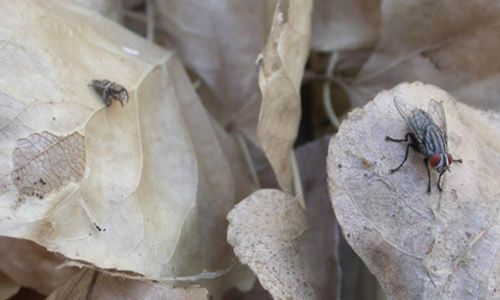
Credit: Lisa Taylor, UF/IFAS
Habronattus jumping spiders, in particular, are opportunistic and voracious generalist predators. They can be extremely abundant in certain habitats and eat mostly small insects and other arthropods, including many pest species (Taylor 2012, Figure 10). As such, they have the potential to be important players in both natural and agricultural food webs but their role in these systems has not been well studied (see Young and Edwards 1990).
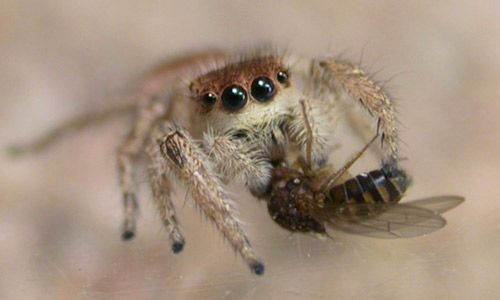
Credit: Lisa Taylor, UF/IFAS
Habronattus jumping spiders also have predators of their own. While there has been little work on the natural predators of Habronattus, there are records of individuals being eaten by larger conspecifics (members of the same species) as well as larger species of spiders (Taylor 2012, Figure 11). The black and yellow mud dauber wasp (Sceliphron caementarium) also takes large numbers of Habronattus in some locations (L. Taylor, unpublished data, Figure 12).
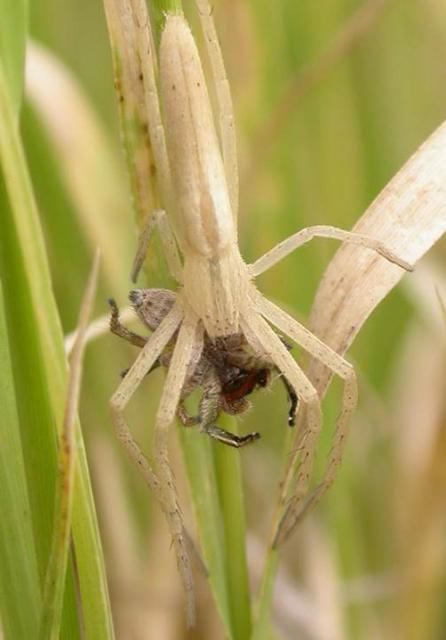
Credit: Lisa Taylor, UF/IFAS
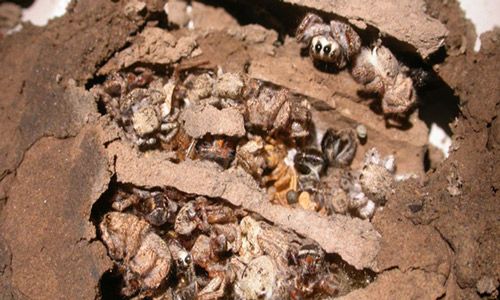
Credit: Lisa Taylor, UF/IFAS
Selected References
Elias DO, Hebets EA, Hoy RR, Mason AC. 2005. Seismic signals are crucial for male mating success in a visual specialist jumping spider (Araneae: Salticidae). Animal Behavior 69: 931-938.
Elias DO, Maddison WP, Peckmezian C, Girard MB, Mason AC. 2011. Orchestrating the score: Complex multimodal courtship in the Habronattus coecatus group of Habronattus jumping spiders (Araneae: Salticidae). Biological Journal of the Linnean Society 105: 522-547.
Foelix RF. 2011. Biology of Spiders. Oxford University Press. New York. 419 pp
Forster LM. 1977. A qualitative analysis of hunting behavior in jumping spiders (Araneae: Salticidae). New Zealand Journal of Zoology 4: 51-62.
Griswold CE. 1987. A revision of the jumping spider genus Habronattus F.O.P. Cambridge (Araneae: Salticidae), with phenitic and cladistic analysis. University of California Publications in Entomology 107: 1-344.
Harland D, Li D, Jackson R. 2012. How animals see the world: Comparative behavior, biology, and evolution of vision. Oxford University Press, New York p. 133-164.
Jackson RR. 1992. Eight-legged tricksters. BioScience 42: 590-598.
Jackson RR, Pollard SD. 1996. Predatory behavior of jumping spiders. Annual Review of Entomology 41: 287-308.
Lim MLM, Li D. 2006. Behavioral evidence of UV sensitivity in jumping spiders (Araneae: Salticidae). Journal of Comparative Physiology 192: 871-878.
Maddison W, Hedin M. 2003. Phylogeny of Habronattus jumping spiders (Araneae: Salticidae), with consideration of genital and courtship evolution. Systematic Entomology 28: 1-22.
Maddison W. 1995. Habronattus. Version 01 January 1995. http://tolweb.org/Habronattus/3069/1995.01.01 in The Tree of Life Web Project. (14 July 2017)
Masta SE, Maddison, WP. 2002. Sexual selection driving diversification in jumping spiders. Proceedings of the National Academy of Sciences of the United States of America 99: 4442-4447.
Nakamura T, Yamashita S. 2000. Learning and discrimination of colored papers in jumping spiders (Araneae, Salticidae). Journal of Comparative Physiology A Sensory, Neural, and Behavioral Physiology 186: 897-901.
Richman DB, Jackson RR. 1992. A review of the ethology of jumping spiders (Araneae, Salticidae). Bulletin of the British Arachnological Society 9: 33-37.
Taylor LA, Clark DL, McGraw KJ. 2011. Condition dependence of male display coloration in a jumping spider (Habronattus pyrrithrix). Behavioral Ecology and Sociobiology 65: 1133-1146.
Taylor LA. 2012. Color and communication in Habronattus jumping spiders: Tests of sexual and ecological selection. Arizona State University. Tempe, Arizona. (14 July 2017)
Taylor LA, McGraw KJ. 2013. Male ornamental coloration improves courtship success in a jumping spider, but only in the sun. Behavioral Ecology 24: 955-967.
Taylor LA, Maier EB, Byrne KJ, Amin Z, Morehouse NI. 2014. Colour use by tiny predators: Jumping spiders show colour biases during foraging. Animal Behaviour 90: 149-157.
World Spider Catalog 2015. World Spider Catalog. Natural History Museum Bern, version 16.5. (14 July 2017)
Young OP, Edwards GB. 1990. Spiders in United States field crops and their potential effect on crop pests. Journal of Arachnology 18: 1-27.
Zurek DB, Cronin TW, Taylor LA, Byrne K, Sullivan ML, Morehouse NI. 2015. Spectral filtering enables trichromatic vision in colorful jumping spiders. Current Biology 25: R403-404.